PRO TIP
Use the verb APPLY for liquids, thin materials or sheets
This person is applying window film

Use the verb INSTALL for systems, parts, or large pieces of material
This person is installing a door

Vocabulary tutorial
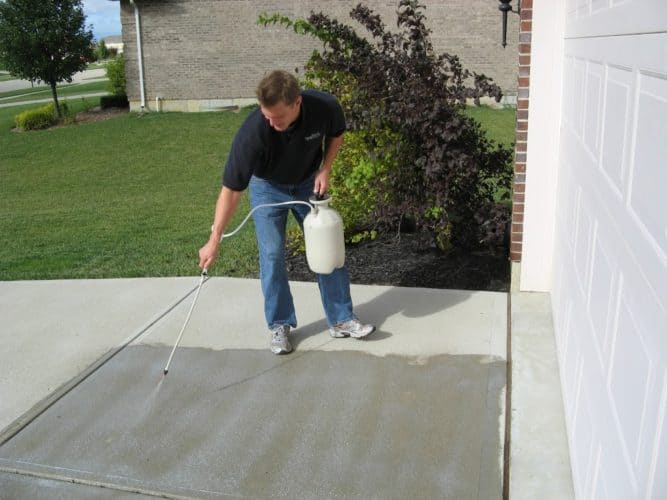
Sealer is a liquid product that is applied to concrete. It is similar to paint, but is clear. It helps protect the concrete from water, but is NOT waterproof and won’t prevent water from passing through the concrete if it cracks.
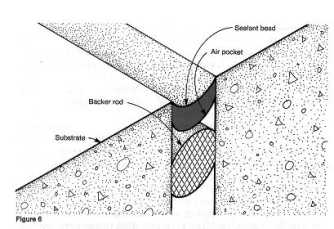
Sealant: Sealant is different than ‘sealer.’ Sealant is a highly technical material used to seal a joint between materials. It is used to make a durable, waterproof joint that allows movement. It is installed according to strict specifications.
Finish can be any final, visible material that has a good appearance (wood panel, wallpaper, paint, stucco, etc).

Fill and sand: often there are holes in wall and ceiling finishes after installation. The painting subcontractor fills them with putty and then sands (rubs with sandpaper to make a smooth finish) the area before painting.
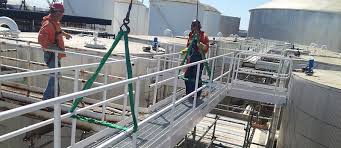
Miscellaneous Metals: Miscellaneous metals typically include items of steel, and sometimes aluminum that are not part of the building structure: Ladders, connectors, railings, etc.
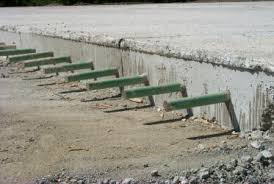
Dowels: are pieces of reinforcing steel used in concrete. They are cast in one piece of concrete and connect it to the next piece of concrete poured on top or next to it.
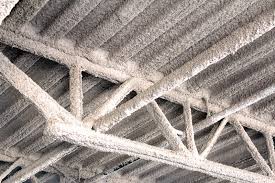
Fireproofing: is a layer of material sprayed on structural steel members. It has different thicknesses, according to the fire rating and steel members.
WORDS IN CONTEXT
Look at the nouns in blue after the blanks below. According to the rules above, which is the best verb to use?
1. Many general contractors require the precast subcontractor to __________ the sealer to all panels.
APPLY sealer
2. Normally, the painting subcontractor will fill and sand any nail holes after the material is in place, and then __________ the final finish.
APPLY a finish
3. The insulation subcontractor will always furnish and__________ the horizontal roof insulation below the structural roof deck.
INSTALL roof insulation
4. The flooring subcontractors will provide and __________ this small wood base trim.
INSTALL wood trim
5. The metal panel subcontractor should __________ all caulking and sealants at the perimeter of their panel systems.
INSTALL sealant.
This is a difficult question. Look at the photo of a sealant joint above. Is the sealant applied to the surface? It’s actually between two objects. Is the sealant a thin coating? It’s actually a system that includes backer rod or breaker tape and fits inside a joint. Generally we use the word ‘install’ if the material is inside something.
6. The miscellaneous metals subcontractor should furnish and __________ all steel railings.
INSTALL steel railings
7. The rebar subcontractor should always furnish and __________ the dowels for the concrete masonry unit (CMU) work.
INSTALL dowels
8. There is obviously no perfect time to __________ fireproofing.
APPLY fireproofing
Fireproofing is a thin coating applied to the surface of steel.
These word associations are called collocations. Below is a more detailed explanation with more examples.

LANGUAGE DEEP DIVE
Understanding “Apply” vs “Install” in Construction English
The distinction between “apply” and “install” reflects how construction professionals think about materials and installation processes. Understanding when to use each verb helps you communicate precisely in specifications, submittals, and coordination meetings across architecture, engineering, and construction. In construction documentation, verb choice carries technical meaning and affects scope definitions between trades. This distinction is part of the broader pattern of construction action verbs used throughout project delivery.
The Pattern: Surface Treatment vs System Installation
Apply: Liquids, Coatings, and Thin Materials
Use “apply” when the material goes onto a surface as a coating, film, or thin layer. The verb suggests spreading, brushing, rolling, or spraying material that conforms to the substrate. Applied materials typically have no independent structure—they depend entirely on the surface beneath them.
Common materials that are “applied”:
- Liquid coatings: paint, sealer, waterproofing liquid, stain
- Thin films: window film, vapor retarder, self-adhered membrane
- Spray-applied products: fireproofing, insulation foam, texture coating
“The painting contractor will apply two coats of primer before the finish paint.”
“Workers apply liquid waterproofing to the foundation walls before backfilling.”
The key characteristic: these materials become part of the surface rather than sitting as independent components. When you apply paint, the paint and wall become one assembly.
Install: Systems, Components, and Assemblies
Use “install” when placing a manufactured component, system, or substantial piece of material. The verb suggests positioning, connecting, fastening, or assembling elements that maintain their individual identity. Installed items typically arrive on site as prefabricated units or materials that require assembly.
Common materials and systems that are “installed”:
- Building components: doors, windows, equipment, fixtures
- System assemblies: HVAC systems, electrical panels, plumbing fixtures
- Structural elements: steel beams, precast panels, wood trusses
- Finish materials: flooring, ceiling tiles, wall panels, trim
- Technical systems: sealant joints, insulation boards, membrane systems
“Mechanical contractors install rooftop HVAC units on structural curbs.”
“Glaziers will install insulated glass units in the curtain wall frames.”
The key characteristic: these materials or systems maintain their identity after placement. An installed door is still a door—a distinct component within the wall.
The Tricky Exception: Sealant
Sealant creates the most confusion because it arrives as a viscous material (suggesting “apply”) but functions as an engineered joint system (suggesting “install”). Industry practice strongly favors “install sealant” because proper sealant installation involves multiple components: joint preparation, backer rod or bond breaker tape, tooling to proper profile, and achieving specific joint geometry. This complexity makes it a system installation rather than simple surface application.
“The curtain wall contractor will install sealant at all perimeter joints.”
“Sealant must be installed according to manufacturer specifications and ASTM standards.”
Compare this to sealer, which is simply brushed or sprayed onto a surface with minimal preparation. Sealer is applied. Sealant is installed.
Other Common Materials
Waterproofing membranes: Liquid waterproofing is “applied” like paint. Sheet membrane waterproofing is “installed” like a system with laps, terminations, and mechanical attachment.
Fireproofing: Spray-applied fireproofing (SFRM) is always “applied” even though it requires specialized equipment. The material is sprayed onto steel surfaces as a coating.
Thin materials: Don’t assume thin always means “apply.” Thin metal panels, glass, and sheet materials are “installed” because they’re placed as discrete components with fasteners. The distinction is less about thickness and more about whether the material maintains independent identity.
Material descriptions: When specifying how materials are composed or fabricated, the choice between “made of” and “made from” signals different information—whether the original material remains recognizable in the finished product or undergoes transformation during manufacturing. This precision matters in product submittals and technical specifications.
Professional Communication and Common Errors
Matching Verbs to Materials
When you encounter new materials, ask yourself: Does this material go onto a surface and become part of it, or does it maintain its identity as a separate component? Is it liquid, thin, and spread, or is it manufactured, assembled, and positioned? The answer guides your verb choice.
Reading Specifications for Scope
When you review specifications to understand scope, pay attention to apply vs install. Sections that primarily use “apply” describe coating or surface treatment work—typically simpler scope. Sections that primarily use “install” describe component or system work—typically more complex with more coordination requirements.
Writing Clear Scope Descriptions
When you write scope descriptions for estimates, contracts, or work packages, choose verbs carefully. “Provide and apply paint” is different from “provide and install painting systems.” Be especially careful at scope boundaries between trades. If you’re defining who provides fireproofing, say “apply spray-applied fireproofing” to clarify it’s a coating. If you’re defining who provides sealant, say “install sealant joints” to clarify the full system.
Avoiding Common Errors
Literal translation problems: Non-native English speakers sometimes directly translate from their language, missing the technical distinction in English. When in doubt, check industry specifications or manufacturer literature to see which verb professionals use for that specific material.
Overcorrecting based on formality: Some learners think “install” sounds more professional than “apply,” so they use it for everything. This creates awkward phrases like “install paint” or “install primer.” Both verbs are equally professional; choose based on the material and method, not perceived formality.
Ignoring industry conventions: Even when logic suggests one verb, industry convention might favor another. “Install sealant” is conventional even though the material is viscous. “Apply fireproofing” is conventional even though the work requires specialized equipment. Learn the conventions by reading specifications and following how experienced professionals describe work.
Related Verb Patterns
Understanding apply/install helps you recognize similar verb distinctions in construction English. For a comprehensive look at action verbs used throughout construction, see our guide to construction action verbs and their collocations.
Surface treatment verbs: apply, spray, brush, roll, trowel
Component placement verbs: install, mount, set, place, erect
Connection verbs: fasten, attach, connect, anchor, secure
These patterns appear throughout construction documentation and help clarify installation methods and scope boundaries between trades. Understanding when to use each verb type is essential for clear communication about materials, systems, and construction methods.
Further Study and Application
This apply/install distinction represents a broader pattern in construction English: verb choice reflects technical understanding, not just vocabulary preference. Similar distinctions exist throughout construction terminology, and learning to recognize these patterns builds professional fluency.
To develop this skill, read technical specifications with attention to verb patterns. Notice how Division 07 uses different verbs for different waterproofing systems. Observe how Division 09 distinguishes between surface treatments and installed finish systems.
Practice writing scope descriptions using correct verbs. When you draft emails, RFIs, or technical descriptions, consciously choose between apply and install based on the material and installation method. This deliberate practice builds the automatic fluency needed for professional workplace communication.
This vocabulary forms part of English for Specific Purposes (ESP) for the construction industry. Understanding these distinctions helps architects write clear specifications, helps engineers describe installation requirements accurately, and helps contractors define scope precisely. Whether you work in architecture, engineering, construction management, or project coordination, mastering these verb patterns supports clear communication about materials, methods, and responsibilities across all project phases and disciplines.




